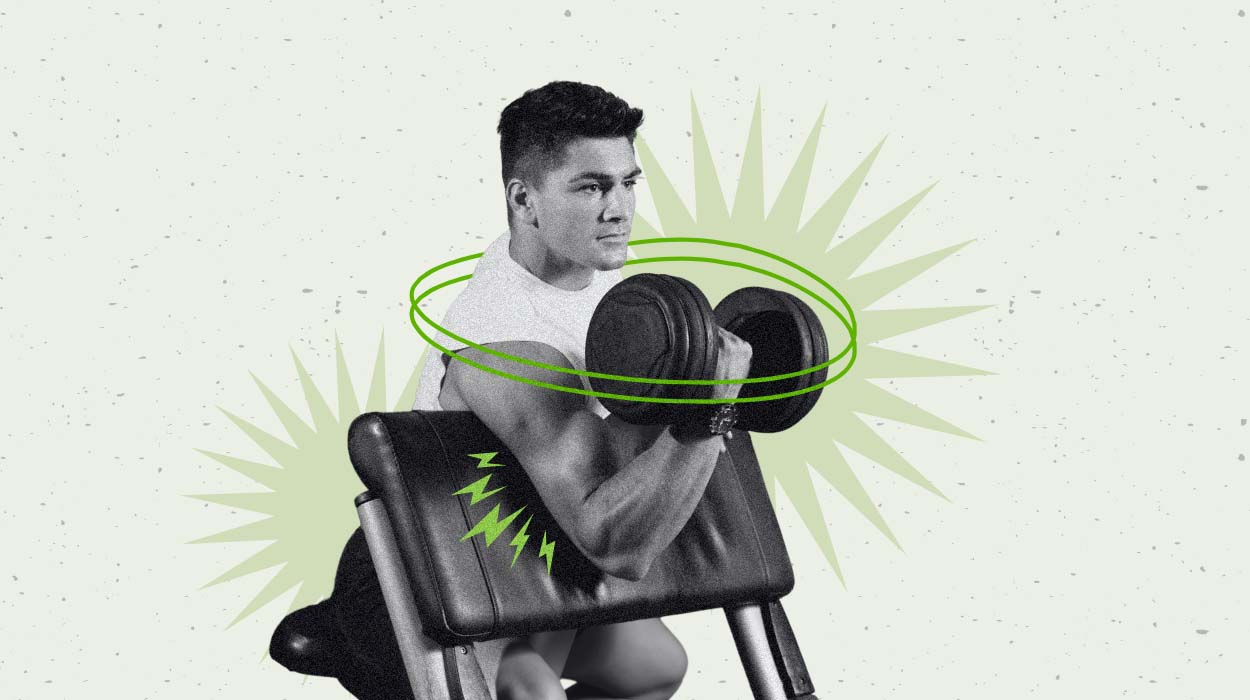
Dumbbell forearm workouts are a transformative approach to building strength and resilience in your arms. Often overlooked in broader fitness routines, these exercises are key to enhanced grip, improved dexterity, and a balanced physique.
This article covers the benefits of these exercises by offering a blend of practical techniques and insightful tips. Whether you’re a seasoned athlete or a fitness enthusiast, mastering these forearm dumbbell workouts can elevate your overall chest and arm workout training regime.
Forearm Workouts With Dumbbells To Improve Strength
For effective forearm strengthening, try these top dumbbell exercises:
- Dumbbell Wrist Curl: Targets forearm flexors and boosts grip strength.
- Hammer Curl: Engages biceps and brachioradialis and enhances arm balance.
- Reverse Curl: Focuses on forearm extensors and improves wrist stability.
- Farmer’s Walk: A full-body exercise significantly enhancing grip and forearm endurance.
Each exercise offers a unique approach to building forearm strength and complements a comprehensive arm workout routine.
Best Dumbbell Forearm Workouts In 2024
Engaging in good dumbbell forearm workouts is a strategic step toward achieving well-rounded arm strength and endurance. These exercises are vital for anyone aiming to elevate their fitness game and enhance their grip strength and overall arm functionality.
As we explore each workout, remember that these exercises are pieces of a fitness puzzle. They fit seamlessly with routines like long head bicep exercises to complete your upper body routine.
Seated Dumbbell Wrist Curl
When you engage in the dumbbell wrist curl, you’re directly targeting the muscles in your forearms, specifically the flexors. This exercise is perfect for boosting grip strength and wrist stability – key elements in daily activities and various sports.
As you sit and curl those dumbbells, you focus on precise muscle engagement with each controlled movement. It’s this simplicity and direct approach that makes the dumbbell wrist curl so effective for forearm training.
Consistently including this exercise in your routine increases your forearm endurance and complements your upper-body strength. Exercises like these, alongside routines such as pull-up alternatives, contribute to developing muscular forearms and balancing out your fitness regime.
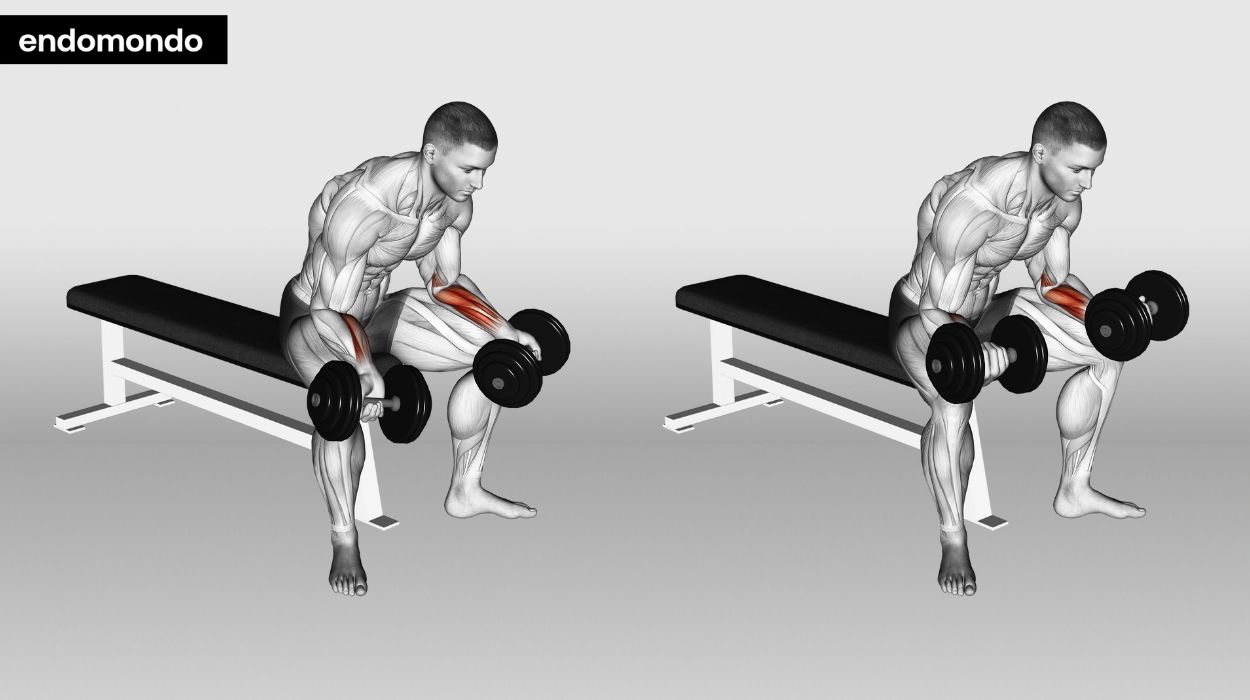
How to do:
- Begin by sitting on a flat bench with your legs shoulder-width apart. Hold a dumbbell in each hand with your palms facing up. Rest your forearms on your thighs, ensuring your wrists are just beyond your knees.
- Grip the dumbbells firmly and curl your wrists upwards as far as you can go. Focus on using your forearm muscles to execute the movement, keeping your arms and shoulders stationary. This isolates the flexor muscles effectively.
- Slowly lower the dumbbells back to the starting position, controlling the movement throughout. Ensure that the descent is just as deliberate as the curl, as this part of the exercise is equally important for muscle development.
- Continue repeating the curls for your set number of reps. Maintain a smooth, steady rhythm, ensuring that each curl is as precise as the last. Avoid rushing through the movements.
Tips:
- Keep your forearms still; only your wrists should move.
- Use a weight that allows control and a full range of motion.
- Incorporate reverse wrist curls to balance forearm strength.
Optimal Sets And Reps: For optimal results, aim to perform 3 sets of 12-15 reps, maintaining a controlled motion and steady rhythm throughout.
Standing Dumbbell Hammer Curl
The hammer curl is a great bicep workout to add to your routine because it engages the biceps and brachioradialis, a muscle in the forearm. With dumbbells in hand, the hammer curl involves a neutral grip — palms facing each other — which differentiates it from traditional bicep curls and places more emphasis on your forearm muscles.
The motion of the hammer curl is straightforward yet effective, combining arm strength with endurance. This exercise is especially beneficial if you want to add diversity to your arm workouts and build a more balanced muscle profile. As you integrate hammer curls, remember they complement other specialized exercises like lateral head tricep exercises, contributing to an all-encompassing arm strengthening regime.
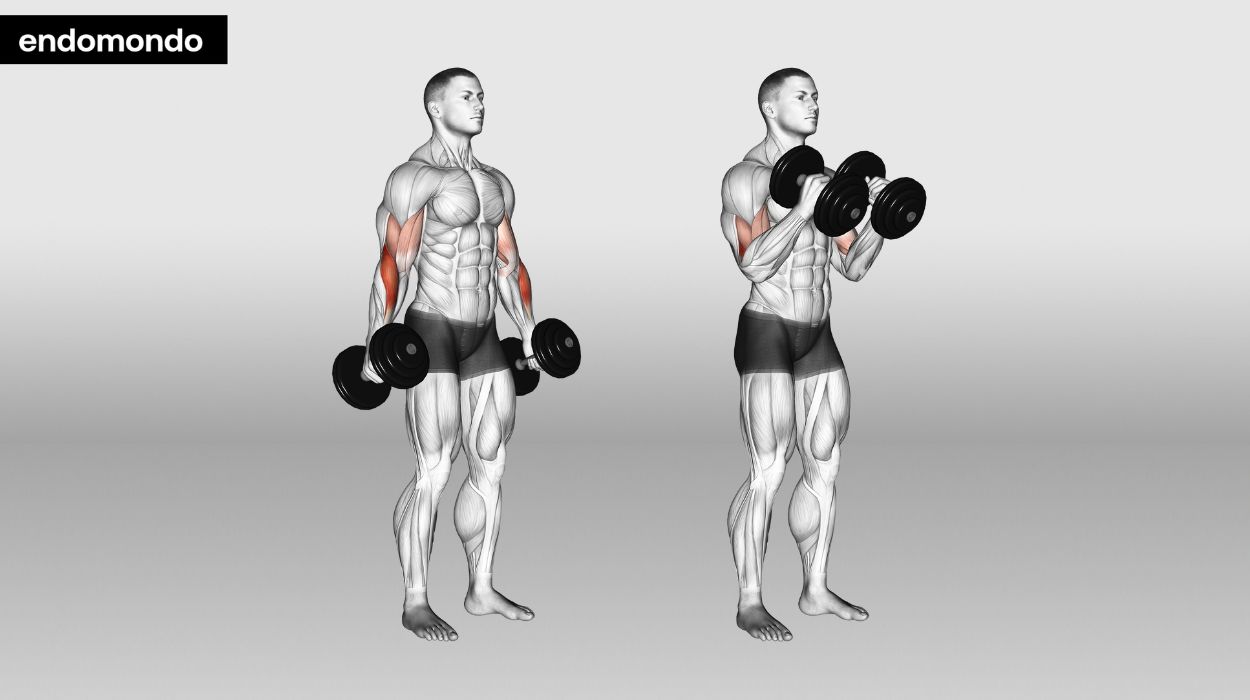
How to do:
- Starting Position: Stand upright with your feet shoulder-width apart. Hold a dumbbell in each hand with your arms at your sides and palms facing each other. Keep your back straight and chest up.
- The Curl: With a firm grip, lift the dumbbells by bending your elbows and keeping your upper arm stationary. The dumbbells should move toward your shoulders, but your palms should continue facing each other throughout the movement.
- Peak Contraction: Once the dumbbells reach shoulder level, pause briefly to squeeze your biceps and forearm muscles. This maximizes muscle engagement.
- The Descent: Slowly lower the dumbbells back to the starting position. Ensure the movement is controlled, focusing on the downward motion as much as the upward curl.
- Repetition and Rhythm: Continue the curls for your set number of repetitions. Maintain a steady pace, ensuring each curl is executed with precision.
Tips:
- Keep your elbows close to your body.
- Avoid swinging the weights; use a controlled motion to keep the focus on the arm muscles.
Optimal Sets And Reps: Perform 3 sets of 10-12 reps for optimal effectiveness, focusing on a controlled motion and a consistent pace throughout each set. This approach ensures you’re fully engaging the target muscles, maximizing the benefits of the exercise.
Standing Reverse Dumbbell Curl
The reverse curl is a dynamic forearm workout that specifically targets your forearm extensors and the brachioradialis muscle. It stands out for its unique grip and the way it challenges different muscle groups compared to the standard curl.
Holding the dumbbells with an overhand grip, this exercise shifts the focus to a great forearm exercise. As part of a comprehensive arm strengthening program, reverse curls work seamlessly alongside exercises in your barbell arm workout. It helps create a well-rounded approach to arm fitness.
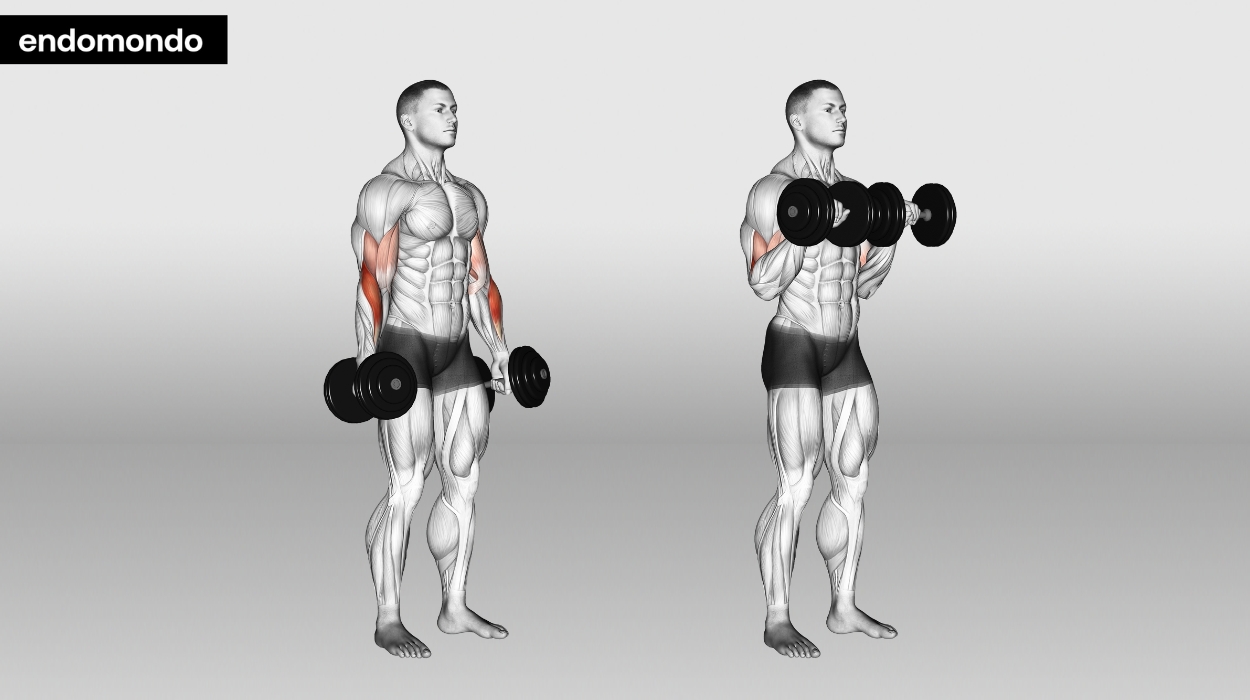
How to do:
- Stand with your feet hip-width apart, holding a dumbbell in each hand. Use a palms-down wrist curl, creating an overhand grip with arms extended along your sides. Keep your back straight and shoulders relaxed.
- Keep your core tight as you bend your elbows to lift the dumbbells. The movement should come from your forearms, not your back or shoulders. Curl the free weights towards your shoulders, keeping your palms facing down in a reverse wrist curl.
- When the dumbbells reach the top, near shoulder level, hold briefly. This is where you’ll feel the maximum engagement in your forearm muscles. Ensure your elbows stay close to your body.
- Slowly lower the dumbbells back to the starting position. Make the downward motion just as deliberate as the upward curl to maximize muscle activation.
- Keep your movements steady and controlled throughout the exercise. Avoid swinging the weights or using momentum. This ensures that your forearms are doing the work, not gravity.
Tips:
- Keep your wrist mobility firm throughout the exercise.
- Focus on using your forearms to lift the weight, not your biceps.
Optimal Sets And Reps: For the most effective results, aim to complete 3 sets of 10-12 reps. This repetition range is ideal for strengthening your forearm muscles, enhancing both form and function.
Standing Dumbbell Farmer’s Walk
The farmer’s walk is a powerful yet straightforward exercise that transcends typical dumbbell forearm workouts by engaging your entire body. This functional exercise not only fortifies your forearms but also enhances your grip strength, core stability, and overall endurance.
You engage a wide range of muscle groups by simply walking with heavy weights in each hand. This exercise is great if you want to build functional strength [1] that applies to daily activities. The farmer’s walk challenges your ability to maintain a strong grip and proper posture under a sustained load.
This directly translates to improved performance in sports and other physical tasks. It’s a testament to the saying that sometimes, simplicity is the key to effectiveness.
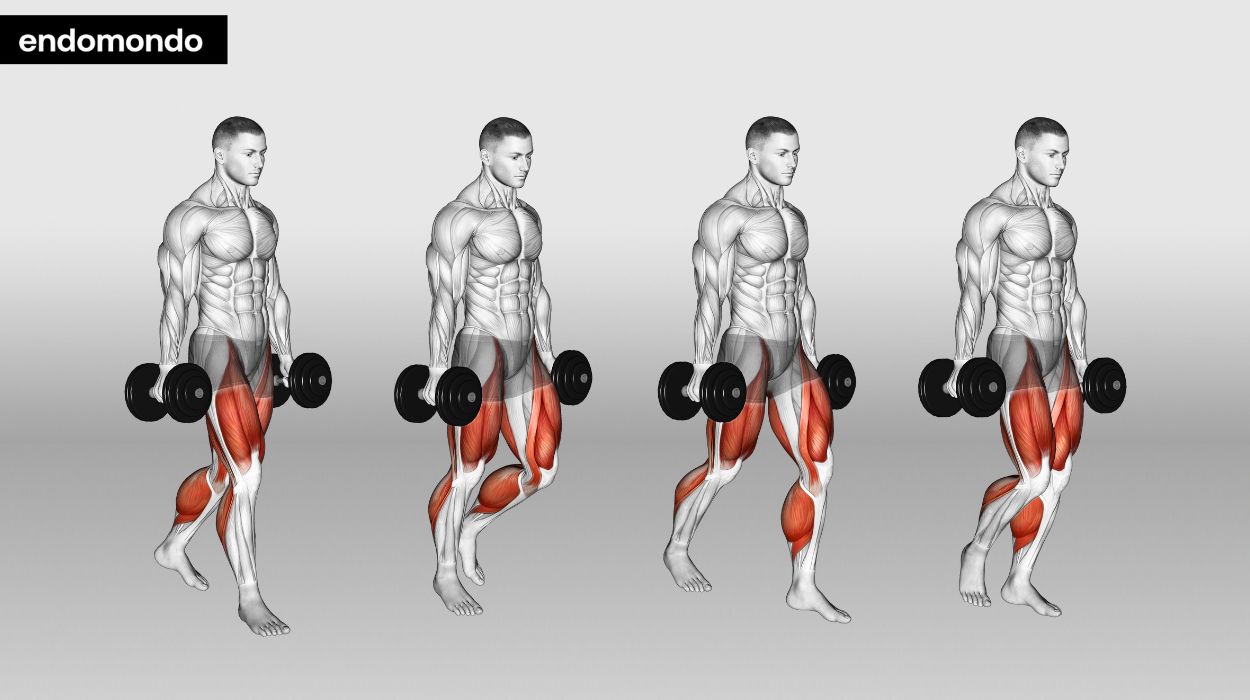
How to do:
- Begin by standing upright, feet shoulder-width apart. Choose a pair of heavy dumbbells and hold one in each hand at your sides. Ensure that your grip is firm and your spine is neutral.
- Bend at the knees and hips to lift the dumbbells off the ground, like a deadlift. Straighten your back as you stand up fully, keeping the weights at your sides. Engage your core to stabilize your body.
- Start walking forward in a controlled manner. Keep your pace steady and your strides even. You should focus on maintaining a strong grip on the dumbbells and a straight posture.
- As you walk, keeping your core engaged is crucial. This helps maintain balance and protect your spine, especially under the added weight.
- Continue walking for a set distance or time. Your goal should be to keep moving without compromising your form or grip.
- After completing the walk, carefully bend your knees and hips to lower the dumbbells back to the ground. Avoid any jerky movements or bending at the waist.
Tips:
- Keep your back straight and shoulders back.
- Choose a weight that challenges your grip without compromising form.
Optimal Sets And Reps: For the most effective training, aim to complete 2-3 sets of 30-60 seconds walk. This duration and frequency are ideal for maximizing the benefits of the Farmer’s Walk, challenging your grip, and improving endurance without compromising form.
Function And Anatomy Of The Forearm
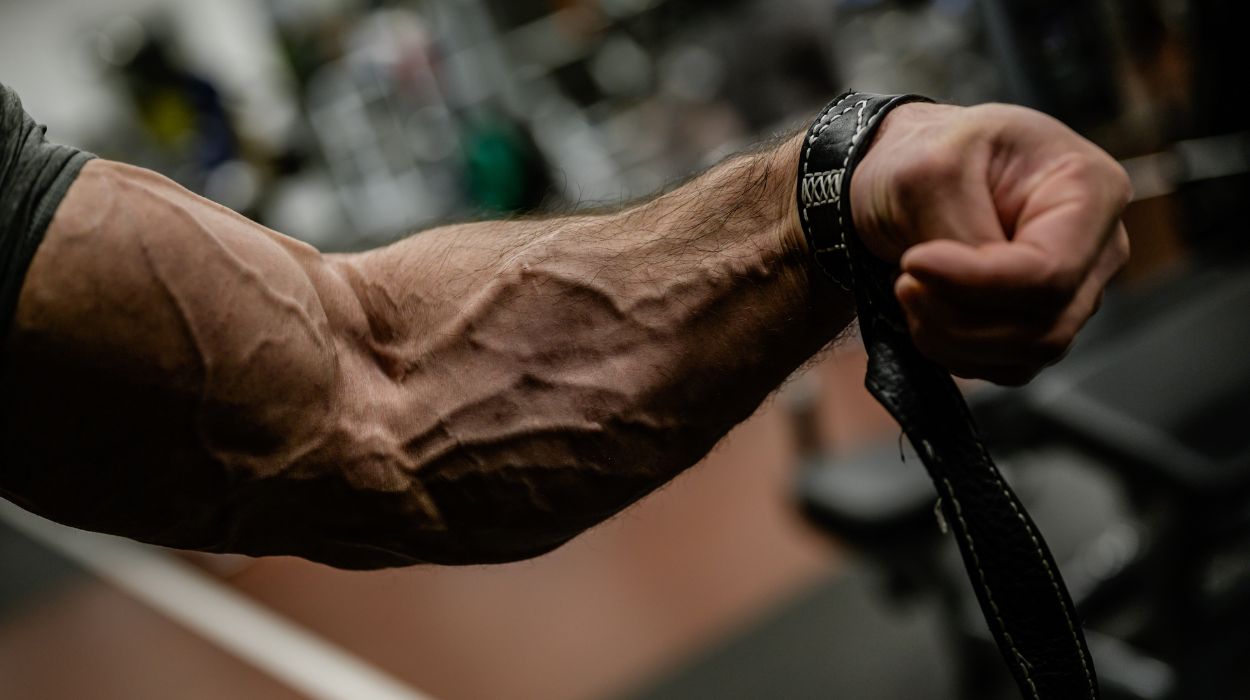
Your forearms are a complex network of twenty muscles, tendons, and bones that work together to facilitate a wide range of movements. Understanding this anatomy can enhance your approach to incorporating forearm exercises with dumbbells and help you appreciate the importance of each movement.
The primary muscles in your forearms include the flexors and extensors. The flexors, located on the inside of your forearm, are responsible for bending your wrist and fingers. They play a key role in grip strength, crucial for tasks ranging from lifting weights to opening jars.
On the other side, the extensors,[2] found on the outside of the forearm, facilitate the straightening of your wrist and fingers. These muscles are essential for actions like releasing objects or performing a backhand in tennis.
Beneath these muscles lie two main bones – the radius and the ulna. These bones provide structural support and are involved in the rotation of your forearm, such as when you turn a doorknob or twist a screwdriver. The interplay between muscles and bones in your forearm allows for the dexterity and strength [3] needed for both everyday activities and specialized tasks.
By strengthening these muscles through exercises like dumbbell forearm workouts, you enhance their size and definition and improve overall functionality. Strong forearms can lead to better performance in sports, easier execution of daily tasks, and a reduced risk of injuries.
Benefits Of Forearm Workouts

When you dedicate time to dumbbell forearm workouts, you’re enhancing numerous aspects of your physical health and daily life. Here’s why these workouts are a game-changer for your fitness routine:
Improved Grip Strength
Your grip is fundamental in almost every upper body workout. By strengthening your forearms, you increase your ability to hold onto weights for longer periods. This improved grip also translates to everyday life tasks, making activities like carrying groceries or opening jars much easier.
Enhanced Sports Performance
Many sports rely on strong forearms and wrist stability. Whether you’re swinging a tennis racket, throwing a baseball, or climbing, stronger forearms can significantly improve your performance [1] and reduce the risk of sports-related injuries.
Better Muscle Balance And Symmetry
Focusing on your forearms ensures a balanced development of your arm muscles. This not only enhances the overall aesthetics of your arms but also prevents muscle imbalances that could lead to injuries.[4]
Increased Endurance And Fatigue Resistance
Forearm workout with dumbbells can increase the endurance of your arm muscles, allowing you to perform at a higher level for longer. This is especially beneficial in activities that require sustained grip or arm strength. Just be sure you maintain good posture throughout all exercises.
Prevention Of Repetitive Strain Injuries
Regular forearm exercises can help prevent conditions [5] like tennis elbow or carpal tunnel syndrome. Weak forearm muscles and repetitive motions often cause these conditions.
Conclusion
These workouts offer a comprehensive approach to enhancing not just your forearm strength but your overall physical capability. As you incorporate the best forearm dumbbell exercises, you’re sculpting stronger arms and fortifying your daily life with improved functionality and endurance.
Remember, the power of these workouts extends beyond the gym — they’re a testament to how targeted exercise can significantly elevate your quality of life and athletic performance. So, embrace these workouts with enthusiasm and consistency, and watch as they transform your strength, inside and out.
Frequently Asked Questions
Incorporate a variety of forearm-focused exercises like wrist curls and hammer curls, progressively increasing the weight for muscle growth.
Dumbbells are highly effective for forearm strength due to their versatility and the range of exercises possible.
It’s advisable to allow rest days for muscle recovery, aiming for 2-3 times per week.
Aim for 10-15 reps per set, adjusting based on your fitness level and specific goals.
Resources
- Hindle, B.R., Lorimer, A., Winwood, P. and Keogh, J.W.L. (2019). The Biomechanics and Applications of Strongman Exercises: a Systematic Review. Sports Medicine – Open, 5(1). doi:https://doi.org/10.1186/s40798-019-0222-z.
- Forman, D.A., Forman, G.N., Avila-Mireles, E.J., Mugnosso, M., Zenzeri, J., Murphy, B. and Holmes, M.W.R. (2020). Characterizing forearm muscle activity in young adults during dynamic wrist flexion–extension movement using a wrist robot. Journal of Biomechanics, 108, p.109908. doi:https://doi.org/10.1016/j.jbiomech.2020.109908.
- Sobinov, A.R. and Bensmaia, S.J. (2021). The neural mechanisms of manual dexterity. Nature Reviews Neuroscience, [online] pp.1–17. doi:https://doi.org/10.1038/s41583-021-00528-7.
- Neme, J.R. (2022). Balancing Act: Muscle Imbalance Effects on Musculoskeletal Injuries. Missouri medicine, [online] 119(3), pp.225–228. Available at: https://www.ncbi.nlm.nih.gov/pmc/articles/PMC9324710/.
- Ünver, S. and Akyolcu, N. (2018). The Effect of Hand Exercise on Reducing the Symptoms in Hemodialysis Patients with Carpal Tunnel Syndrome. Asian Journal of Neurosurgery, [online] 13(1), pp.31–36. doi:https://doi.org/10.4103/ajns.AJNS_343_16.




